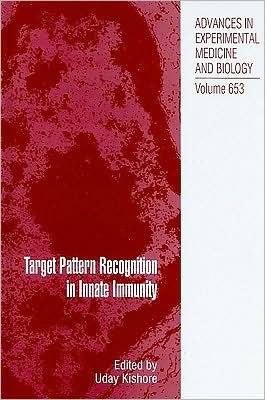

 |

|

Sold Out
Book Categories |
1. Macrophage Pattern Recognition Receptors in Immunity, Homeostasis and Self Tolerance Subhankar Mukhopadhyay, Annette Plüddemann, and Siamon Gordon
Abstract Introduction The Scavenger Receptor Family Class A Scavenger Receptors SR-A (SR-AI/II)
MARCO SRCL-I/ CLP-I C-Type Lectin Receptors C-Type Lectins with a Single CRD C-Type Lectins with Multiple CRDs NK-Like C-Type Lectin-Like Receptors Self Tolerance in Innate Immunity Conclusion
2. Pattern Recognition by Toll-Like Receptors Stefan Bauer, Thomas Müller, and Svetlana Hamm
Abstract Introduction Toll-Like Receptors and Their Ligands Bacterial Recognition by TLRs Viral Recognition by TLRs Recognition of Fungi and Protozoan Parasites by TLRs Cellular Localization of TLRs Recognition of Endogenous Ligands by TLRs and Involvement in Autoimmunity TLR Signaling Interferon Production by TLRs TLR Structure TLR Expression in Cells of the Adaptive Immune System Conclusion
3. NOD-Like Receptors—Pivotal Guardians of the Immunological Integrity of Barier Organs Philip Rosenstiel and Stefan Schreiber
Abstract Introduction NOD-Like Receptors—Phylogenetically Ancient Molecular Platforms of the Innate Immune System Modular Domain Structure NLRs and the Recent Rise of Barrier Diseases Plasticity of NLR Function Conclusions
4. Toll-Like Receptors and NOD-Like Receptors: Domain Architecture and Cellular Signalling Tanja Langefeld, Walid Mohamed, Rohit Ghai, and Trinad Chakraborty
Abstract Introduction Toll-Like Receptors Myd88 Dependent TLR Signalling Myd88 Independent TLR Signalling Nod-Like Receptors Conclusions
5. Humoral Pattern Recognition Molecules: Mannan-Binding Lectin and Ficolins Steffen Thiel and Mihaela Gadjeva
Abstract Introduction Biochemistry Biology Conclusion
6. Lung Surfactant Proteins A and D as Pattern Recognition Proteins Patrick Waters, Mudit Vaid, Uday Kishore, and Taruna Madan
Abstract Introduction Collectin Structure Overview N-Terminal Region Collagen Region Neck Region Carbohydrate Recognition Domain (CRD)
SP-A and SP-D Bind Lipid via Their CRDs Calcium Ions Are Required for CRD Function Factors Affecting Interaction with Polysaccharides Directing the Immune Response Specific Examples of SP-A and SP-D as PRRs Fungus and Yeast Viruses SP-A and SP-D in Protection against Allergens and Pulmonary Hypersensitivity Phenotype and Susceptibility of SP-A and SP-D Gene Deficient Mice Conclusion
7. Pattern Recognition by Pentraxins Alok Agrawal, Prem Prakash Singh, Barbara Bottazzi, Cecilia Garlanda, and Alberto Mantovani
Abstract Pentraxins Short Pentraxins: CRP and SAP Long Pentraxin: PTX3
Conclusions
8. Target Pattern Recognition by Complement Proteins of the Classical and Alternative Pathways Yu-Hoi Kang, Lee Aun Tan, Maria V. Carroll, Madeleine E. Gentle, and Robert B. Sim
Abstract The Complement System C1q and C1 Structure Biosynthesis of C1q Target Recognition by C1q Structural Basis of C1q Binding to Targets C1q Receptors C1q across the Animal Kingdom Properdin and the Alternative Pathway
9. Pattern Recognition in Phagocytic Clearance of Altered Self Yoshinobu Nakanishi, Peter M. Henson, and Akiko Shiratsuchi
Abstract Roles and Mechanisms of Phagocytosis Recognition of Altered Self by Phagocytes Consequences of Phagocytic Clearance of Apoptotic Cells Fate of Necrotic Cells or Cells Dying by Other Modes Concluding Remarks
10. Structural Basis of Pattern Recognition by Innate Immune Molecules Eamon P. McGreal
Abstract Introduction Molecules Containing Leucine Rich Repeats (LRRs)
Carbohydrate Recognition by C-Type Lectin and C-Type Lectin-Like Molecules Emerging Innate Immune Pattern Recognition Molecules Conclusions
11. Lessons from the Fly: Pattern Recognition in Drosophila melanogaster Subhamoy Pal and Louisa P. Wu
Introduction The Immune Response in the Fly The Pattern Recognition Receptors Conclusion
12. Immune Recognition of Plasmodium-Infected Erythrocytes Damien V. Cordery and Britta C. Urban
Malaria Clinical Immunity to P. falciparum Infection Involvement of Pattern Recognition Receptors in Plasmodium Infection Recognition of Plasmodium-iRBCs by Toll-Like Receptors Recognition of Plasmodium-iRBCs by Scavenger Receptors Conclusions and Perspectives
13. Innate Immune Recognition in Tuberculosis Infection Anthony G. Tsolaki
Abstract Introduction Receptor-Mediated Phagocytosis of M. tuberculosis Complement Receptors Mannose Receptors Scavenger Receptors Survival of M. tuberculosis inside the Phagosome Immune Recognition of M. tuberculosis Cytokines Induced in Response to M. tuberculosis Infection Concluding Remarks
Login|Complaints|Blog|Games|Digital Media|Souls|Obituary|Contact Us|FAQ
CAN'T FIND WHAT YOU'RE LOOKING FOR? CLICK HERE!!! X
 You must be logged in to add to WishlistX
 This item is in your Wish ListX
 This item is in your CollectionTarget Pattern Recognition in Innate Immunity, Vol. 653
X
 This Item is in Your InventoryTarget Pattern Recognition in Innate Immunity, Vol. 653
X
 You must be logged in to review the productsX
 X
 X

Add Target Pattern Recognition in Innate Immunity, Vol. 653, Target pattern recognition in innate immunity is responsible for the immediate, usually protective, responses shown against invading microorganisms, and it is the principal feature of self and non-self recognition by virtue of the recognition of structure, Target Pattern Recognition in Innate Immunity, Vol. 653 to the inventory that you are selling on WonderClubX
 X

Add Target Pattern Recognition in Innate Immunity, Vol. 653, Target pattern recognition in innate immunity is responsible for the immediate, usually protective, responses shown against invading microorganisms, and it is the principal feature of self and non-self recognition by virtue of the recognition of structure, Target Pattern Recognition in Innate Immunity, Vol. 653 to your collection on WonderClub |